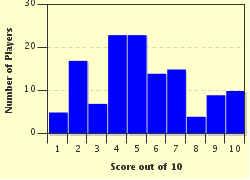Quiz Answer Key and Fun Facts
1. J - I was born in New York, and went to Germany prior to the outbreak of WWII. I was a radio broadcaster that sent out propaganda messages. After the war I was convicted of treason and hanged.
2. K - The Nazis slaughtered over 21,000 Polish officers and soldiers at the Katyn forest in 1940.
3. L - Hitler referred to this person as being "the last great German to be born in the Ostmark".
To whom was Hitler referring?
4. M - What country was considered as a dumping ground for Jews that were destined to be deported from Germany as part of the "Jewish Problem"?
5. N - The "Nacht and Nebel" order was issued by Hitler in 1941.
Of the following statements, which one is INCORRECT?
6. O - Hitler used the Olympic Games of 1936 to showcase the Nazi regime.
What number in the modern Olympiad were these games, and where were they held?
7. O - The Ostmedaille, or Eastern Medal, was issued to those soldiers that fought on the Russian front.
What was the nickname given to that medal by the troops?
8. P - The 'Pour le Mérite' was highly coveted and was the highest award available during WWI. A lot of these awards were given to the flying aces after shooting down eight enemy planes.
The Nazis referred to 'Pour le Sémite' during WWII. To what did it refer?
9. Q - Vidkun Quisling was a Norwegian politician during WWII.
His name would later become synonymous, not only in Norway, but across the world, with what word?
10. R - What was the role that Hanna Reitsch played in the Third Reich?
Source: Author
Lssah
This quiz was reviewed by FunTrivia editor
bloomsby before going online.
Any errors found in FunTrivia content are routinely corrected through our feedback system.


